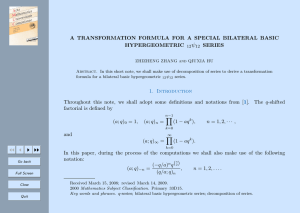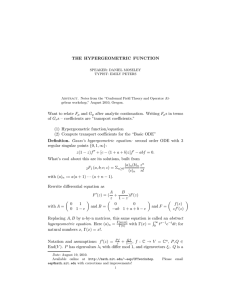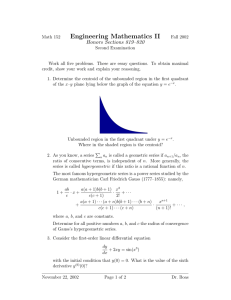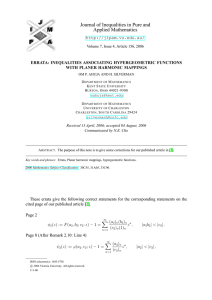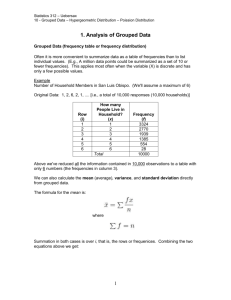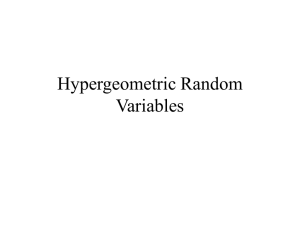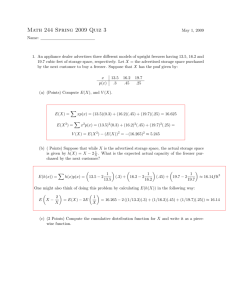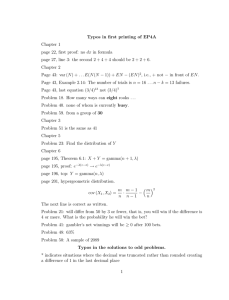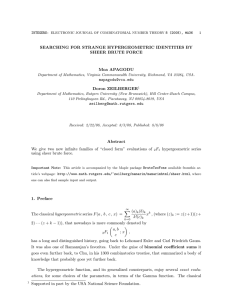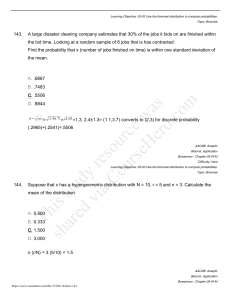ψ 201 A TRANSFORMATION FORMULA FOR A SPECIAL BILATERAL BASIC HYPERGEOMETRIC
advertisement
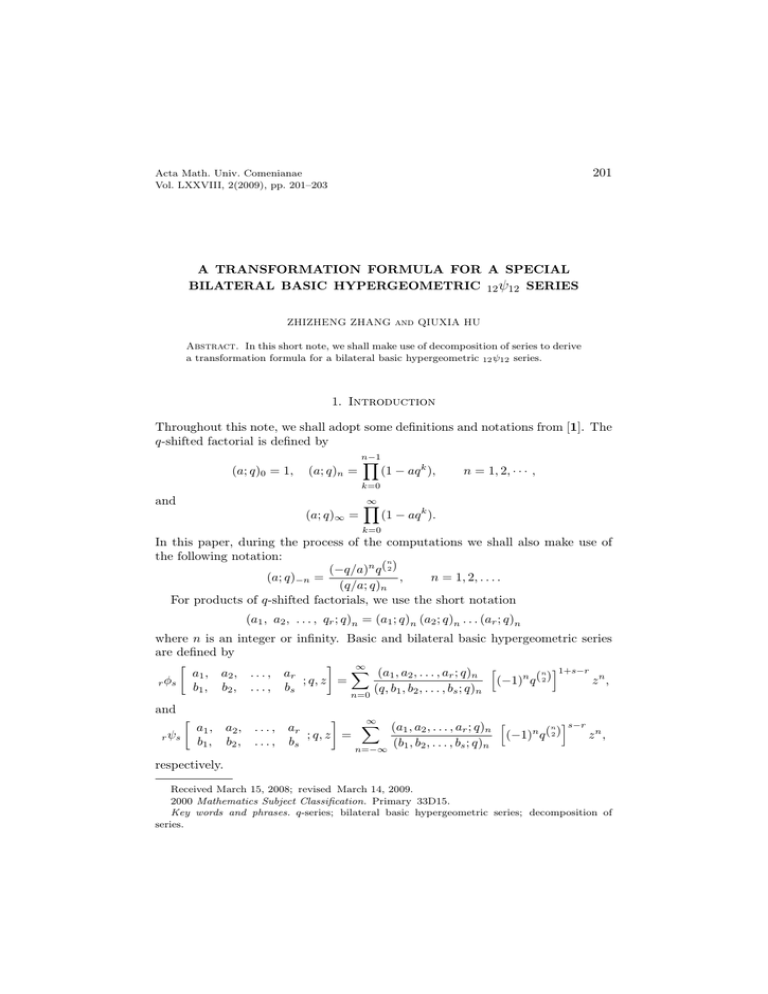
201 Acta Math. Univ. Comenianae Vol. LXXVIII, 2(2009), pp. 201–203 A TRANSFORMATION FORMULA FOR A SPECIAL BILATERAL BASIC HYPERGEOMETRIC 12 ψ12 SERIES ZHIZHENG ZHANG and QIUXIA HU Abstract. In this short note, we shall make use of decomposition of series to derive a transformation formula for a bilateral basic hypergeometric 12 ψ12 series. 1. Introduction Throughout this note, we shall adopt some definitions and notations from [1]. The q-shifted factorial is defined by (a; q)0 = 1, (a; q)n = n−1 Y (1 − aq k ), n = 1, 2, · · · , k=0 and (a; q)∞ = ∞ Y (1 − aq k ). k=0 In this paper, during the process of the computations we shall also make use of the following notation: n (−q/a)n q ( 2 ) (a; q)−n = , n = 1, 2, . . . . (q/a; q)n For products of q-shifted factorials, we use the short notation (a1 , a2 , . . . , qr ; q)n = (a1 ; q)n (a2 ; q)n . . . (ar ; q)n where n is an integer or infinity. Basic and bilateral basic hypergeometric series are defined by X ∞ i1+s−r n (a1 , a2 , . . . , ar ; q)n h a1 , a2 , . . . , ar (−1)n q ( 2 ) zn, φ ; q, z = r s b1 , b2 , . . . , bs (q, b1 , b2 , . . . , bs ; q)n n=0 and r ψs a1 , b1 , ∞ is−r X n (a1 , a2 , . . . , ar ; q)n h a2 , . . . , ar ; q, z = (−1)n q ( 2 ) zn, b2 , . . . , bs (b , b , . . . , b ; q) 1 2 s n n=−∞ respectively. Received March 15, 2008; revised March 14, 2009. 2000 Mathematics Subject Classification. Primary 33D15. Key words and phrases. q-series; bilateral basic hypergeometric series; decomposition of series. 202 ZHIZHENG ZHANG and QIUXIA HU In this short note, we make use of the idea decomposition of series to derive a formula for a bilateral basic hypergeometric 12 ψ12 series. 2. Main results In the proof of Theorem 1, we use of the following very-well-poised 8 φ7 transformation formula: (1) 1 1 1 1 1 1 a2 q a, qa 2 , −qa 2 , y2, −y 2 , (yq) 2 , −(yq) 2 , x ; q; 2 1 1 1 1 1 1 1 1 8 φ7 y x a 2 , −a 2 , aqy − 2 , −aqy − 2 , aq 2 y − 2 , −aq 2 y − 2 , aq/x 2 2 2 (aq, a q/y ; q)∞ a q y, xy/a = ; q, 2 2 φ1 2 aq/x (aq/y, a q/y; q)∞ y x 2 provided | ya2 xq | < 1, which is equivalent to [1, Equation (3.4.7)] by a substitution of variables. Theorem 1. For |q| < 1 and |q 3 /y 2 x| < 1, we have (2) 5/2 q , −q 5/2 , y 1/2 , qy 1/2 , −y 1/2 , −qy 1/2 , (yq)1/2 , 12 ψ12 1/2 1/2 2 −1/2 3 −1/2 2 −1/2 3 −1/2 3/2 −1/2 q , −q , q y , q y , −q y , −q y , q y , q6 q 3/2 y 1/2 , −(yq)1/2 , −q 3/2 y 1/2 , x, xq ; q2 , 4 2 5/2 −1/2 3/2 −1/2 5/2 −1/2 2 3 q y , −q y , −q y , q /x, q /x y x 2 3 2 3 (q , q /y ; q)∞ q y, xy/q = 2 ; q, 2 . 2 φ1 q 2 /x (q /y, q 3 /y; q)∞ y x Proof. We first write out the left-hand side of (1) explicitly: (3) 2 n ∞ X (a, qa1/2 , −qa1/2 , y 1/2 , −y 1/2 , (yq)1/2 , −(yq)1/2 , x; q)n a q . 2x 1/2 , −a1/2 , aqy −1/2 , −aqy−1/2, aq 1/2 y −1/2 , −aq 1/2 y −1/2 , aq/x; q) y (q, a n n=0 Letting a = q in (3) and after some elementary manipulations, we get 3 n ∞ X (q 3 ; q 2 )n (y 1/2 , −y 1/2 , (yq)1/2 , −(yq)1/2 , x; q)n q 2x 2 ) (q 2 y −1/2 , −q 2 y −1/2 , q 3/2 y −1/2 , −q 3/2 y −1/2 , q 2 /x; q) y (q; q n n n=0 3 2n ∞ X (q 3 ; q 2 )2n (y 1/2 , −y 1/2 , (yq)1/2 , −(yq)1/2 , x; q)2n q = 2 2 −1/2 2 −1/2 3/2 −1/2 3/2 −1/2 2 (q; q )2n (q y , −q y ,q y , −q y , q /x; q)2n y 2 x n=0 3 2n+1 ∞ X (q 3 ; q 2 )2n+1 (y 1/2 , −y 1/2 , (yq)1/2 , −(yq)1/2 , x; q)2n+1 q + 2x 2) 2 y −1/2, −q 2 y −1/2, q 3/2 y −1/2, −q 3/2 y −1/2 , q 2/x; q) y (q; q (q 2n+1 2n+1 n=0 3 2n ∞ X (q 3 ; q 2 )2n (y 1/2 , −y 1/2 , (yq)1/2 , −(yq)1/2 , x; q)2n q = 2x 2 ) (q 2 y −1/2 , −q 2 y −1/2 , q 3/2 y −1/2 , −q 3/2 y −1/2 , q 2 /x; q) y (q; q 2n 2n n=0 3 2n −1 X (q 3 ; q 2 )2n (y 1/2 , −y 1/2 , (yq)1/2 , −(yq)1/2 , x; q)2n q + . 2x 2 ) (q 2 y −1/2 , −q 2 y −1/2 , q 3/2 y −1/2 , −q 3/2 y −1/2 , q 2 /x; q) y (q; q 2n 2n n=−∞ A TRANSFORMATION FORMULA FOR 12 ψ12 SERIES 203 According to the definition of bilateral basic hypergeometric series and combining the two sums of above, the consequence is just the left-hand side of (2). By (1) the desired result is immediate. Note that the left-hand side of (2) can be written in the following compact form: 3 2n ∞ X (x; q)2n q (1 − q 1+4n ) (y; q)4n . 3 /y; q) 2 /x; q) 2x (1 − q) (y (q y 4n 2n n=−∞ Acknowledgment. The authors are very grateful to the anonymous referee for comments and valuable suggestions which helped a lot to improve the original version. This research is supported by the National Natural Science Foundation of China (Grant No. 10771093). References 1. Gasper G. and Rahman M., Basic Hypergeometric Series, 2nd Edition, Encyclopedia of Mathematics and Its Applications 96, Cambridge University Press, Cambridge, 2004. Zhizheng Zhang, Center of Combinatorics and LPMC, Nankai University, Tianjin 300071, P. R. China, e-mail: zhzhzhang-yang@163.com Qiuxia Hu, Department of Mathematics, Luoyang Teachers’ College, Luoyang 471022, P. R. China, e-mail: huqiuxia306@163.com
